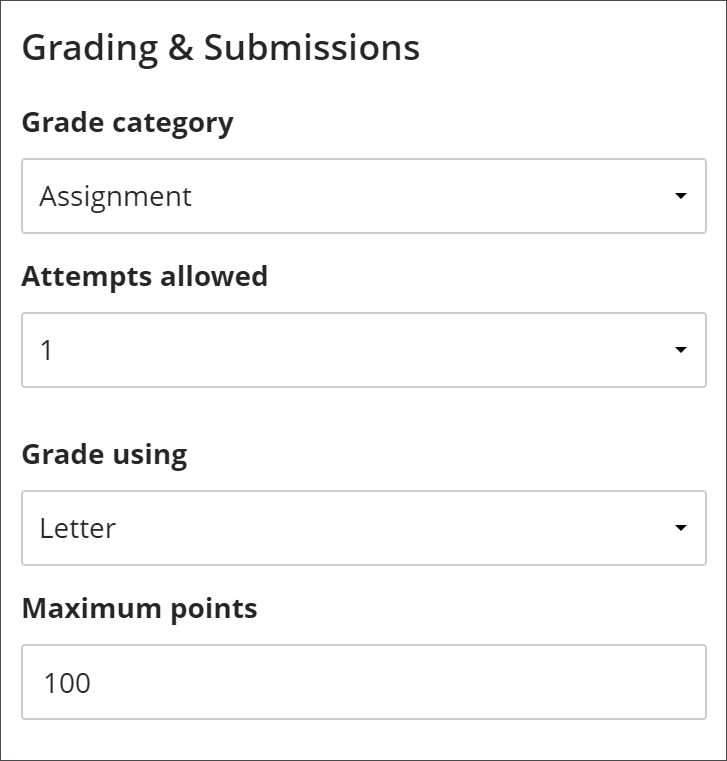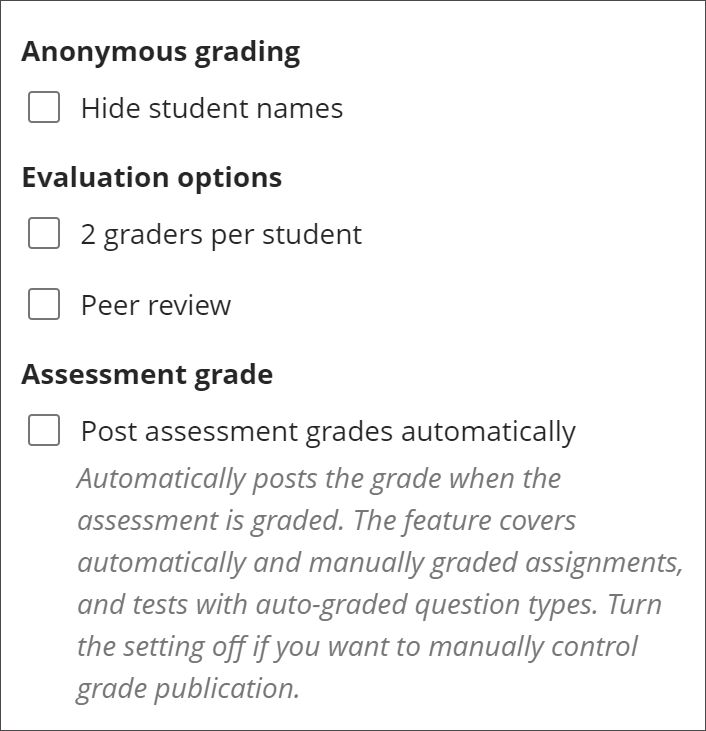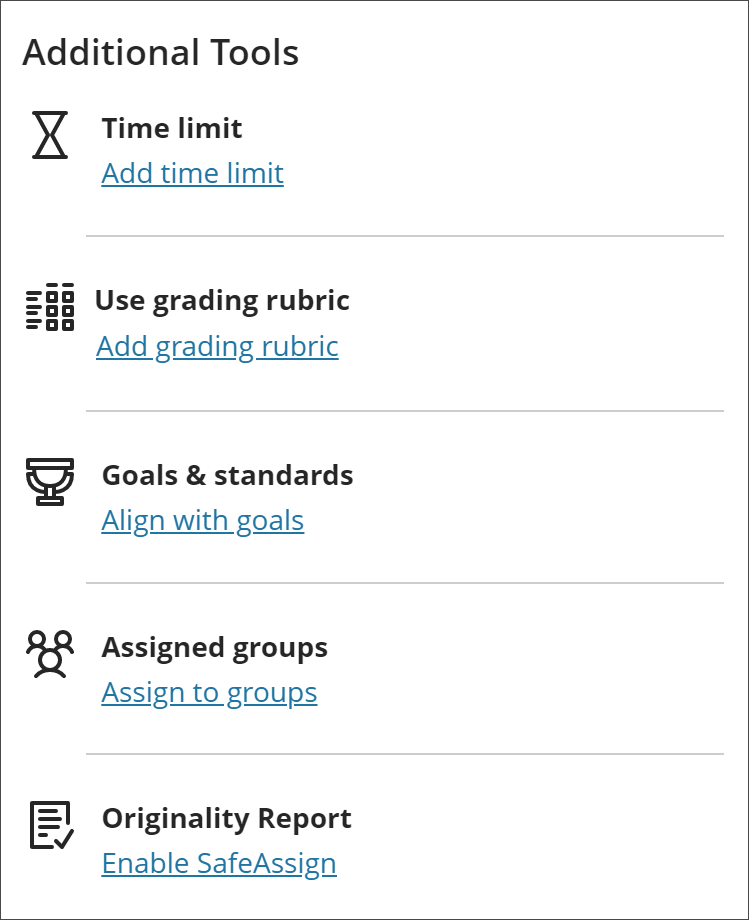Procedure
See also Assessment Tabs (Content & Settings, Submissions, Student Activity, and Question Analysis).
1. On your course content page, select the purple plus in the location where you’d like the assignment added and select Create. It is a best practice to place assignments and assessments within the module or folder housing the content they are associated with.

2. The Create Item side panel opens. Scroll to the Assessment section and select Assignment. The New Assignment page opens.
3. Begin by giving the assignment a title.

4. Type instruction for the assignment, and attach any needed documents
5. After you’ve built your assignment, open the settings panel by clicking on the gear icon by "Assignment Settings". Set a due date, point value, and additional desired grading options (see Assignment Setting Options Explained section below).
6. When finished, select Save.
7. If ready, make the assignment visible to students.
Note: When you create an assignment, a Gradebook item is created automatically.
Assignment Setting Options:
Assignment Setting Options Explained
Distinguishing Assignments and Tests in Ultra
Assignments and Tests (grouped under Assessments in the Course Content Items panel) share the same user interface and options. Many options in the settings are enabled or disabled based on whether at least one question is included in the assessment.
In practice, instructors use these assessments differently. For example, you might create an assignment with instructions for students to submit a file for a grade. In a test, students may answer a series of questions you’ve added to the assessment.
To distinguish between assignments and tests, and to highlight workflows with and without questions, the discussion of assignments will emphasize a workflow without added questions. You may easily add questions to your assignment if you choose.
Details & Information Section
The section Details & Information provides options for assignment submission.

Due Date: enter the Due Date and Time the assignment is due. Once entered, this information funnels into the Activity Stream on the Bb homepage and the Calendar tab both in the course shell and on the Bb homepage. Late submissions appear with a Late label in the course gradebook. You can prohibit students from submitting work after the due date.
Prohibit Late Submissions: This blocks a student from submitting the assignment after the identified due date/time has been completed -- even if an exception is granted. If an assignment is in progress, this attempt will be submitted by the system automatically for grading when the due date/time have been reached.
NOTE: If students have submitted attempts, you cannot change the due date to a date in the past. If the due date has passed, you can't select the Prohibit late submission setting.
Prohibit New Attempts After Due Date: This prevents a student from attempting the assignment after the identified due date/time has passed. This differs from Prohibit Late Submissions in that Late Submissions is submission of an item that is in progress. New Attempts would be attempting to start an assignment after the due date/time has been reached.
Allow Class Conversations: Turns on a class conversation for a discussion (ungraded) around the assignment.
Collect Submissions Offline: If work is to be collected or completed offline, check this box. An assignment created in which work is completed outside of Bb (e.g. a live performance, presentation given in class, completion of work in a tool not integrated into Bb, etc.) will still have a column created in the Gradebook for the assignment and allows for a rubric to be associated with it for grading purposes.
Formative assessment is an essential component of the teaching and learning process. Formative assessment provides ongoing feedback to both instructors and students. Its primary value is that it informs and shapes instruction, guides learning, and supports student progress. Instructors can apply a formative label to assessments and, when selected, this label serves as an indicator and appears to instructors in the following areas:
- Course Content page - on assessments set as formative
- Test and Assignment settings
- Gradebook -- Both List and Grid views
- Student Overview
- Student Activity Overview

Instructors may choose to display this label to students. This helps to inform students that an assessment is formative in its purpose. When displayed to students, the label appears in these areas:
- Course Content page - on assessments set as formative
- Assessment panel before starting an attempt
- Assessment Details & Information panel during and after an assessment
- Assessment header when viewing a submission
- Gradebook (Grid View)
In the Gradebook Grid View, instructors can filter assessments by formative or summative type by clicking the Gear icon to open the side panel, then checking the desired box on Assessment Type. Formative assessments are those with the formative setting selected. Summative assessments are those that do not have the formative setting selected.

This section provides options for assignment type and grading criteria.

Grade Category: The default category is Assignment, however, additional choices are available in the drop-down menu or as additional categories are added to the Gradebook.
Attempts Allowed: Identify the number of attempts at submitting the assignment a student is allowed. When more than one attempt is allowed, an additional menu option of "Grade Attempts" appears to convey to Blackboard how to record the score in the grade book with these choices:
- Average of all attempts
- First attempt with a grade
- Attempt with highest grade
- Last attempt with a grade
- Attempt with lowest grade
See Multiple Attempts to learn more.
Grade Using: Choose from Letter, Points, or Percentage. NOTE: To provide students with a clear understanding of where they stand in the course based on a current level of work completed, faculty are strongly encouraged to keep the grading method consistent; therefore, be purposeful in using Letter, Points, or Percentage throughout the course. Students most often relate to Point values.
Maximum Points: Bb requires a point value always be provided for a graded activity in the course. Enter in the desired point value for the assignment. Add a number value between 0 and 99,999 for your assignment. If you leave this field blank, the number will default to 100.
Anonymous Grading: When you create an assignment without questions, you can enable anonymous grading. Student names are hidden while you grade. You may only add text and files to anonymously graded assignments.

Evaluation Options:
- Check 2 Graders Per Student (known as Parallel Grading) to require two individuals separately grade the assignment (those individuals must hold a role in the course that allows them to grade). Based on roles assigned to each grader, one will serve as the Reconciler who will reconcile the grades between the two graders to determine the final grade awarded.
- Peer Review: Clicking this box enables the Peer Review tool in Bb. NOTE: Peer Review cannot be turned on for assignments that allow multiple attempts. Peer review allows students to review their peers’ work through criteria-based evaluation. Click on Select Peer Settings to assign the number of reviews per student, assessment due date, and peer review due date.
Assessment Grade: Check this box to automatically have scores, whether automatically graded by Bb or manually graded by the instructor, displayed to students in the grade book once grading is completed. Leave the box UNchecked to manually control when grades are released for student viewing.
POST Scores Automatically: When checked, as student work is graded, the score awarded is posted in the Gradebook automatically for students to view. If left UNchecked, then the instructor can opt to release all scores out to all students once all grading is completed. See Posting Scores.
Within the Additional Tools section, the following can be done:

Submitted work can also be viewed from the assignment by clicking the arrow in the right corner:
